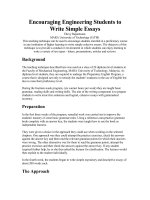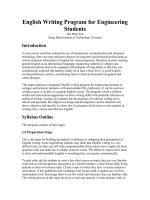Encouraging Engineering Students to Write Simple Essays.doc
Bạn đang xem bản rút gọn của tài liệu. Xem và tải ngay bản đầy đủ của tài liệu tại đây (81.88 KB, 5 trang )
Encouraging Engineering Students to
Write Simple Essays
Thevy Rajaretnam
MARA University of Technology (UiTM)
This teaching technique can be used to encourage students enrolled in a proficiency course
in any institution of higher learning to write simple cohesive essays. The objective of this
technique is to provide a conducive environment in which students can enjoy learning to
write a variety of text types - letters, presentations, articles and reviews.
Background
The teaching technique described here was used on a class of 26 diploma level students in
the Faculty of Mechanical Engineering, MARA University of Technology, Malaysia. As
diploma level students, they are required to undergo the Preparatory English Program, a
course that is designed not only to remedy the students' weakness in the use of English but
also to raise their proficiency level.
During the fourteen-week program, (six contact hours per week) they are taught basic
grammar, reading skills and writing skills. The aim of the writing component is to prepare
students to write error-free sentences and logical, cohesive essays with grammatical
accuracy.
Preparation
In the first three weeks of the program, remedial work was carried out to improve the
students' mastery of some basic grammar rules. Using a reference-cum-practice grammar
book complete with an answer key, the students were taught how to use the book as
independent learners.
They were given a choice in the approach they could use when working on the selected
chapters. One approach was they could attempt the practice exercises, check the answers
against the answer key and then read the relevant grammar points for which their answers
were wrong. The other alternative was for them to read the grammar points, attempt the
practice exercises and then check the answers against the answer key. If any student
required further help, he or she then asked the lecturer for clarification. The lecturer would
then explain to the student individually.
In the fourth week, the students began to write simple expository and descriptive essays of
about 200 words each.
The Approach
A product/process approach was used. In the early stages they began by writing on topics
they were familiar with so that they had the content to write about. They were also
provided the schema or the background knowledge necessary to write on a given topic. The
schema came through three ways - the lecturer, peers or examples of the genre they have to
imitate.
As far as possible, students were from the beginning trained to see writing as a genuine
activity. They wrote for a purpose and for an audience and as such their products included
letters, articles, presentations and reviews.
They were given time to brainstorm for ideas, draft the products, revise them and have
them edited before the final products were submitted for grading. Initially students were
given a choice on whether they prefer revision and editing by their peers or by their
lecturer. They chose to have their work revised and edited by the lecturer.
So, all drafts were written on transparencies using waterproof pens. Each writing
assignment was projected on the screen and the lecturer edited the work line by line,
explaining why she has to make the changes. After having conducted revision and editing
using this approach, the lecturer then began first to underline the parts of the sentences that
needed to be edited. The students themselves suggested how these could be improved. In
time, most of the suggestions came from the students themselves.
Throughout the various stages in the writing process, students were allowed to work in a
non-threatening environment. They worked in groups of four or five. They used
dictionaries. They consulted their peers in the other groups. They chose the people they
wanted to work with. They were allowed to sit anywhere in the classroom and the lecturer
did not walk around to monitor the students' progress. Instead, they would call for the
lecturer if they needed her advice or help. The lecturer would then walk to the group, sit
with them and help them. After which she would return to her seat and wait for other
groups to call for her.
A total of six topics were used. It took about two to four contact hours per week to
complete one activity. The remaining contact hours were used to teach the other
components in the syllabus. By the time the six topics had been covered, it was the ninth
week of the semester. From the tenth to the fourteenth week, the students began to work
individually on examination-type grammar, reading and writing activities.
The Topics
The six topics used to help students to write simple, cohesive 200-word essays with
grammatical accuracy are as follows.
Assignment 1
Getting to know you
Since this is your first writing activity, write a letter to your lecturer telling her about
yourself and the members in your group. Try and limit yourself to about 150 to 200 words.
Assignment 2
Copies of an article entitled "Cane ... no pain, no gain" from The New Straits Times (one of
the local English Language dailies) dated June 30, 2000 about a spade of incidents of
criminal acts involving school children were distributed to the students. As part of this
article, the journalists had also interviewed some famous local personalities regarding their
childhood experiences when they were caned for having committed some misdeed. They
also were asked to explain how the canning has affected their lives. The frank responses of
these personalities were quoted in the article.
The students read this article and then shared their own experiences with the class. The
lecturer too shared her experiences, much to the amusement of the students.
The following situation was then given to the students.
Lately, there has been an increase in criminal acts involving school children. Some say that
bringing back the cane will put an end to the acts of crime. Have you been caned in school?
Has it in any way affected your life? In groups of four, brainstorm, discuss and write about
your experiences. Your article is meant for publication in your faculty's student journal.
Assignment 3
Various types of dictionaries from the students were collected and displayed for the
students to see. These included monolingual, bilingual and pocket-sized dictionaries by
different publishers. A lively discussion was carried out regarding the many uses of the
dictionary. As a result of the discussion, the following outline was conceived and used as a
guideline to write a presentation.
• Introduction
o types
o sizes
o publishers
• Development: uses of a dictionary
o translation
o meaning
o grammar
o spelling
o pronunciation
o history of the word (etymology)
• Conclusion
o importance of a dictionary among undergraduates
when reading reference books
when writing assignments
The following situation was then given.
You have been asked to present a paper on the multiple uses of a dictionary to your class.
In groups of four, discuss, plan and draft your paper. Your paper should not exceed 200
words.
Assignment 4
Students were told in advance to watch the movie The Patriot staring Mel Gibson. A week
before the writing activity, copies of reviews published in two different English Language
dailies were distributed to the students. Students read the reviews and came prepared to
share their opinions about the movie. A lively discussion took place before the following
situation was given.
You have watched the movie The Patriot. As reporters in charge of the entertainment
section of the campus journal, write a short review of the movie in about 200 words.
Assignment 5
Copies of a passage on the importance of coral reefs and the role they play in the lives of
mankind were distributed to the students. The students read the passage and discussed the
issues involved. Where necessary, the lecturer explained the content to the students. Then,
the following situation was given.
Read the passage on the importance of coral reefs and the role they play in the lives of
mankind. Then write a letter to the editor of a local newspaper explaining why coral reefs
should be preserved.
Assignment 6
The students were given two weeks to read one of the short stories in the book Six
American Stories, abridged and simplified by Norman Wymer and published by Thomson
ELT in 1995. Before the writing assignment, the lecturer briefly explained how to write a
book review. The following outline was then written on the whiteboard.
• What is the title of the story and who wrote it?
• What is the story about (synopsis)
• Is it available in hard copy/paperback?
• Is it an abridged or unabridged version of the original story?
• Is the language used simple enough to understand and appreciate?
• Who should read it?
• Why is it worth reading?
The situation given was as follows.
You have been asked to post a review of one of the short stories in the book entitled Six
American Stories, abridged and simplified by Norman Wymer and published by Thomson
ELT, 1995 on the website of your local Residents' Council Book Club. Your review should
be written in about 200 words.
Conclusion
The students generally enjoyed the writing sessions. They were very enthusiastic about the
writing assignments. There were no problems as far as absenteeism was concerned. The
students who were more proficient felt very challenged while those who were less
proficient felt the need to try their level best so as to be able to keep up with their peers.
This approach to help students write simple essays can be used to teach the writing
component in any proficiency course. It can be modified by the teacher to suit her or his
classroom situation, depending on the level of proficiency of the students, the type of
materials available and the number of hours allotted for the course.









